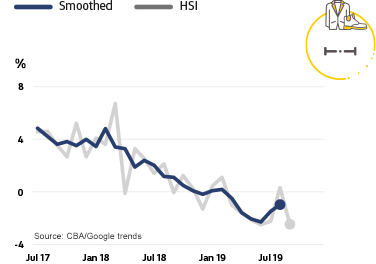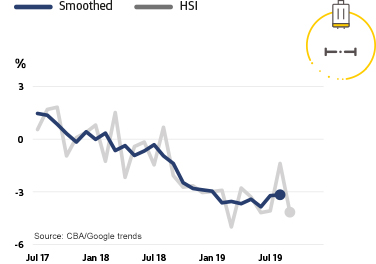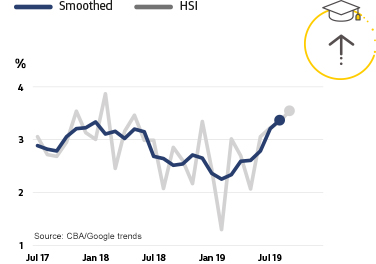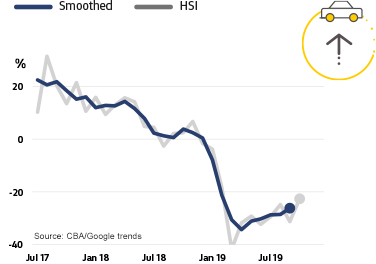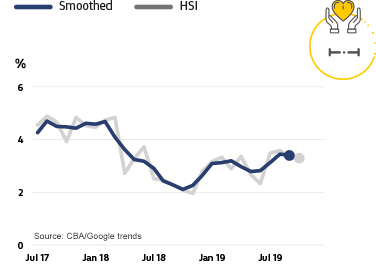CBA’s Chief Economist Michael Blythe has today confirmed that household spending intentions stumbled in September after the positive lead reported last month. Nonetheless, the series also highlights some underlying improvement in spending intentions more broadly.
The Commonwealth Bank Household Spending Intentions (HSI) series offers a forward-looking view by analysing actual customer behaviour from CBA’s transactions data, along with household spending intentions from Google Trends searches. This combination adds to insights on prospective household spending trends in the Australian economy.
Mr Blythe said: “The latest edition of the HSI series shows a disappointing downturn in retail spending intentions.
“While there were some positive signs in sectors where the tax refunds now flowing would most likely be spent, the overall picture is one of continued consumer caution,” Mr Blythe added.
Mr Blythe suggested the pull back in retail spending intentions was potentially a sign that interest rate cuts are blunting some of the stimulus from income tax refunds.
“Our view for some time now is that monetary policy changes do little to support household activity. While a positive ‘wealth effect’ is emerging from rising home prices, consumers interpret rate cuts from record lows as a sign of economic weakness and keep their wallets shut,” Mr Blythe said.
Nevertheless, the overall message from the various HSI measures is that spending intentions edged higher in Q3 and have now bottomed out.
“Spending intentions for entertainment, education and motor vehicles are now pointing up,” Mr Blythe said.
“Also, importantly, the improvement in home buying intentions is holding up – supported by the RBA rate cuts.
“A positive ‘wealth effect’ from the housing market should help support broader economic growth in the year ahead,” Mr Blythe added.
Household Spending Intentions – October 2019 edition
CBA obtains an early indication of spending trends across seven key household sectors in Australia. Apart from home buying, the series covers around 55 per cent of Australia’s total consumer spend across; retail, travel, education, entertainment, motor vehicles, and health and fitness.

| Retail Spending Intentions |
|
| Travel Spending Intentions |
|
| Home Buying Spending Intentions |
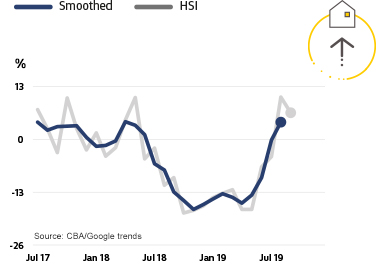 |
| Education Spending Intentions |
|
| Entertainment Spending Intentions |
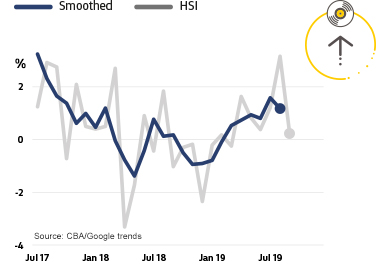 |
| Motor Vehicles Spending Intentions |
|
| Health & Fitness Spending Intentions |
|
To find out more about CBA’s Household Spending Intentions Series, visit www.commbank.com.au/spendingintentions.
Notes for Editors:
About the approach
The new approach focuses on Australian households and their spending intentions. Employing near real-time spending readings from CBA’s household transactions data and combining them with relevant search information from Google Trends was used to map the data results on consumer spending.
About Google Trends
Google Trends is a publically available service that enables people to explore search trends around the world. These searches provide insights into what consumers are doing/researching on the Internet and what their spending intentions are.
Research calendar
CBA’s Household Spending Intentions series is published on the third Tuesday of every month.
Disclaimer
This ‘CBA-Google Household Intentions’ series provides general market-related information, and is not intended to be an investment research report. The ‘CBA-Google Household Intentions’ series has been prepared without taking into account your objectives, financial situation (including the capacity to bear loss), knowledge, experience or needs. Before acting on the information in the ‘CBA-Google Household Intentions’ series, you should consider the appropriateness and, if necessary seek appropriate professional or financial advice, including tax and legal advice. The data used in the ‘CBA-Google Household Intentions’ series is a combination of the CBA Data and Google Trends™ data. Google Trends is a trademark of Google LLC. All customer data used or represented in this report is anonymous and aggregated before analysis and is used and disclosed in accordance with the Commonwealth Bank Group’s Privacy Policy Statement.
Commonwealth Bank of Australia ABN 48 123 123 124 AFSL 234945.




